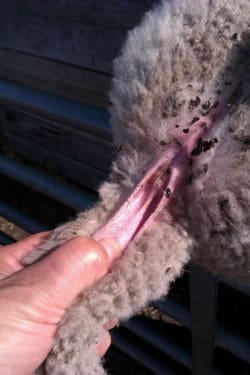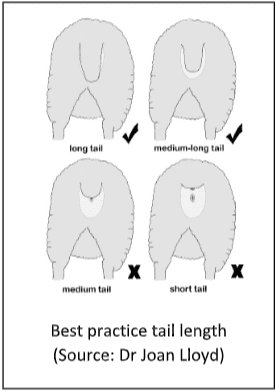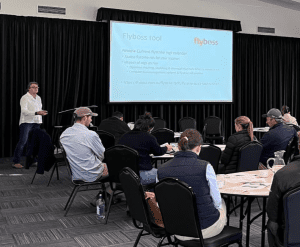
The correct length at which to dock lambs tails, leaving the caudal fold intact. Image – Agriculture Victoria.
TAIL docking lambs is a long-standing practice used to reduce the life-long susceptibility of sheep to breech flystrike.
Regardless of whether lambs are non-mulesed or mulesed, the recommended tail length is the same. Dock at a minimum of three and preferably four palpable joints.
That was the message from Dr Joan Lloyd, from Joan Lloyd Consulting Pty Ltd, who presented best practice tail docking and pain relief options for lamb marking at a recent seminar held in Dunkeld, Victoria. The seminar was part of the MLA Producer Demonstration Site project, ‘Towards non-mulesed sheep’.
Best practice tail length for female lambs is to ensure the healed tail covers the vulva. Dock at a minimum of three and preferably four palpable joints, keeping the caudal folds and bare area on the underside of the tail intact. Dock to the equivalent length in male lambs.
“There is a perception amongst some producers who are moving to a non-mulesed flock that (in addition to other strategies) they need to dock lambs tails shorter to reduce the risk of breech flystrike and dag accumulation,” Dr Lloyd said.
“Short tail length has a negative impact on a range of animal health issues including the susceptibility to breech flystrike, rate of healing after docking and susceptibility to infection, rectal prolapse and cancer,” she said.
 Docking at the recommended length enables sheep to lift their tails which can reduce the risk of dag accumulation and breech flystrike.
Docking at the recommended length enables sheep to lift their tails which can reduce the risk of dag accumulation and breech flystrike.
“These tail length recommendations were developed from a number of large CSIRO studies in the 1930’s and 40’s using unmulesed Merino ewes. These studies included more than 10,000 sheep on five properties in eastern Australia. The results are still relevant today,” she said.
The studies demonstrated that the best protection against breech flystrike was obtained by docking the tails of unmulesed sheep medium-long (3rd joint) or long (4th joint). Medium-long or long was the best length for the tails of both female and male sheep.
Docking the tails of unmulesed sheep at the second joint or shorter resulted in an inferior result, with these sheep experiencing two to three times the rate of breech flystrike as sheep with the tails docked long or medium-long.
Short and medium length tails took longer to heal than medium-long or long tails and were more likely to be infected. Recent research by Dr Lloyd has also demonstrated a link between short docking and arthritis in lambs.
“When it comes to tail docking method, only the use of a gas knife or rubber rings are recommended,” Dr Lloyd said.
Best practice pain relief is important

Dr Joan Lloyd
Dr Lloyd also discussed the important topic of pain relief options at lamb marking. While the use of pain relief at lamb marking is increasing, many producers are still not sure about the best options for their situation.
As reported in Sheep Central on 5th October, survey results from the Sheep Sustainability Framework’s first On-Farm Insights Report showed that 60 percent of the 1203 Merino producers surveyed, and 24pc of the 800 non-Merino producers surveyed, used pain management for tail docking. (https://www.sheepsustainabilityframework.com.au/ )
The survey results highlighted that for those producers using pain relief with the hot knife method for tail docking, 97pc of Merino producers and 88pc of non-Merino producers were using a suitable pain relief product. For those producers using pain relief with the ring method for tail docking, only 1 in 2 were using a suitable pain relief product.
“If using a gas knife for tail docking, best practice is to use a local anaesthetic such as Tri-Solfen® for short-term pain relief and an analgesic (nonsteroidal anti-inflammatory drug, NSAID) for longer term relief. NSAIDs last for varying lengths of time depending on the formulation. There is a gel formulation which is deposited between the teeth and the inside of the cheek of the lamb or other products are given by subcutaneous injection. If using rubber rings for docking you can use the local anaesthetic Numocaine® (with the Numnuts device) and an analgesic,” Dr Lloyd said.
Tail docking investigations at producer demonstration sites

Lisa Warn speaking at the Dunkeld seminar.
The topic of tail docking technique has frequently come up in the producer group discussions in the MLA PDS project. The PDS is supporting producers to implement best practice when it comes to tail docking length and pain relief. Several producers in Victoria and New South Wales have set up demo sites to investigate if using different types of gas knives makes any difference to the amount of wool on the tail and subsequent of ease of crutching or dag accumulation in non-mulesed sheep.
If you would like support to develop your own management plan and improve your knowledge and skills to enable the transition to non-mulesed operations, click here.
Dr Lloyd has a wealth of experience in veterinary research and diagnostics and been involved in studies on effectiveness of different pain relief products for sheep husbandry procedures. She is also the co-author of “A producer’s guide to sheep husbandry practices” an MLA publication. To access a copy of this publication, click here.

HAVE YOUR SAY